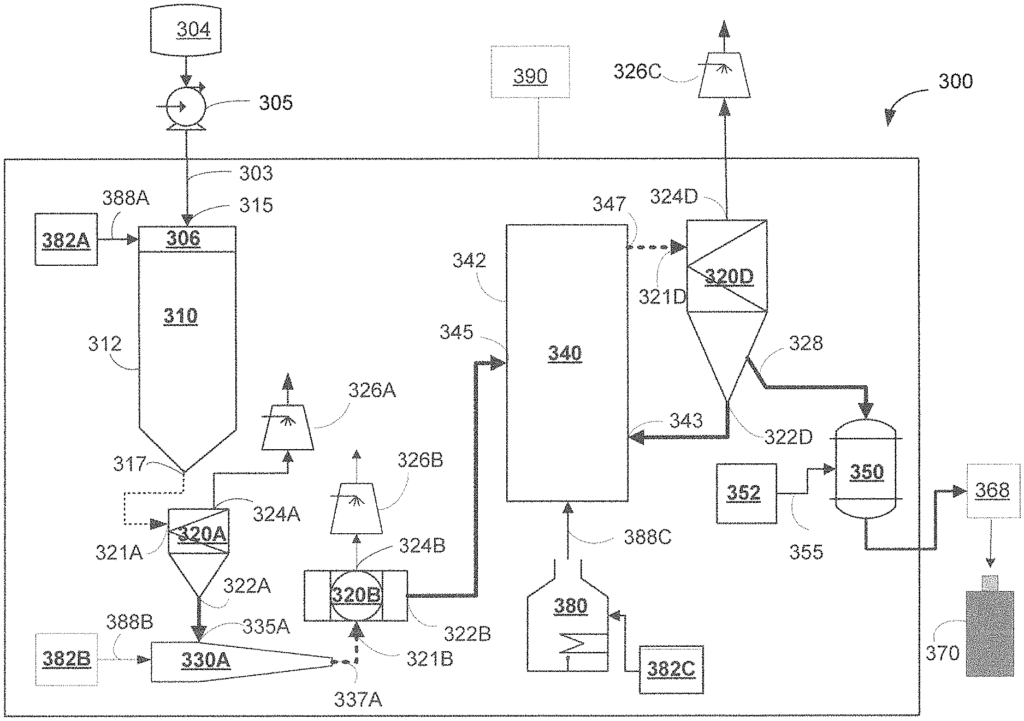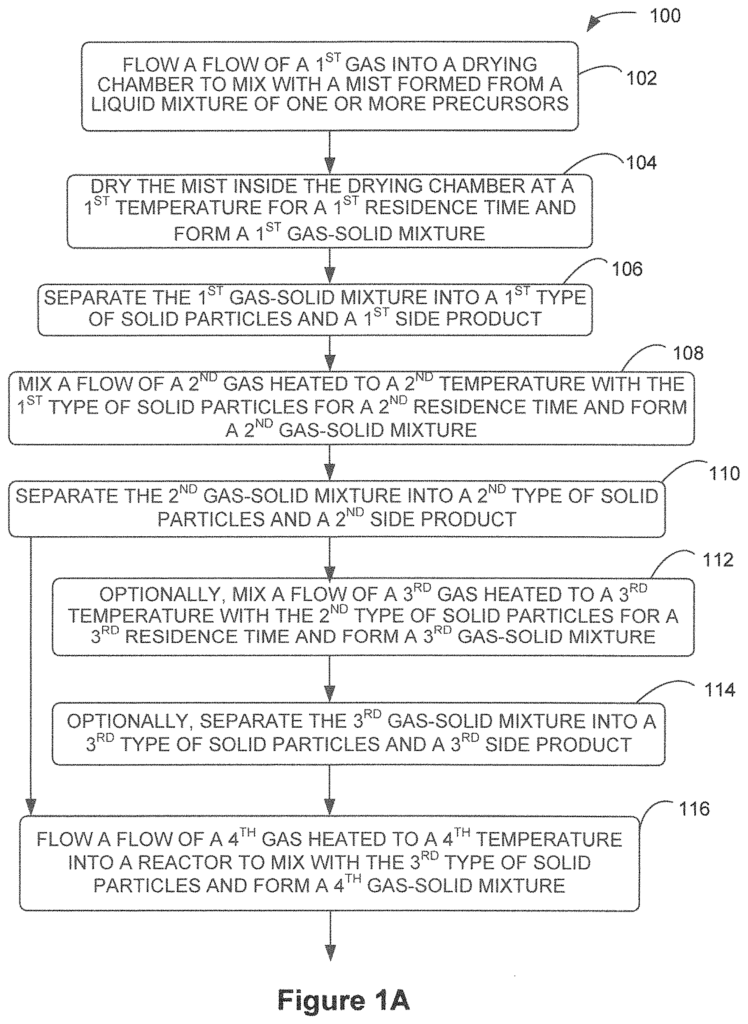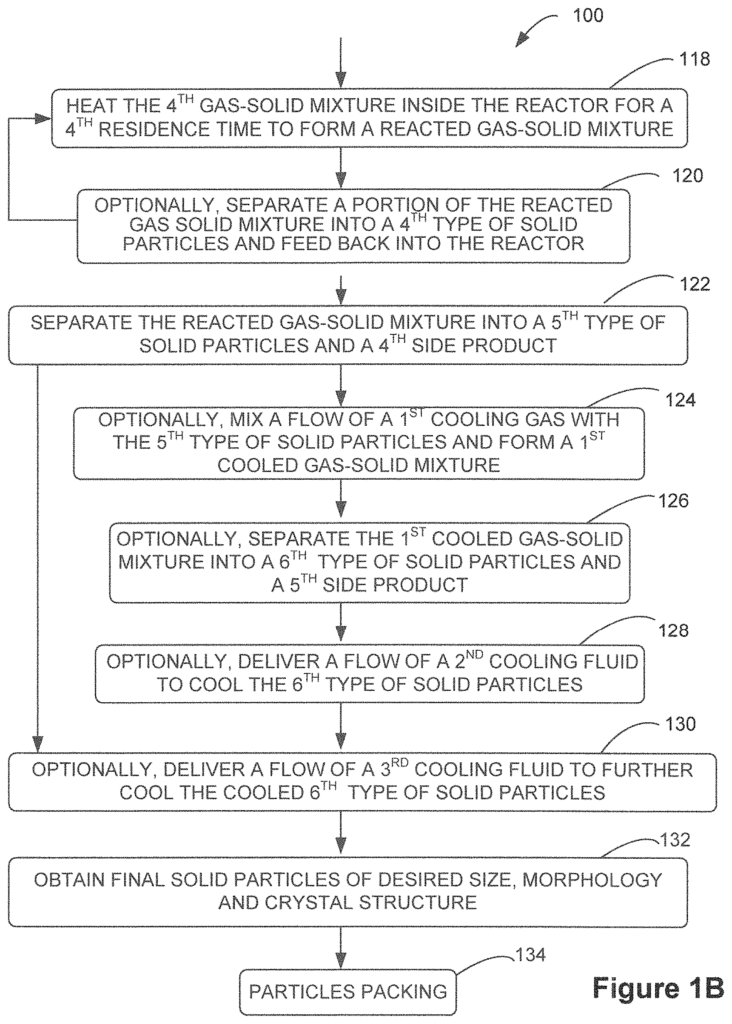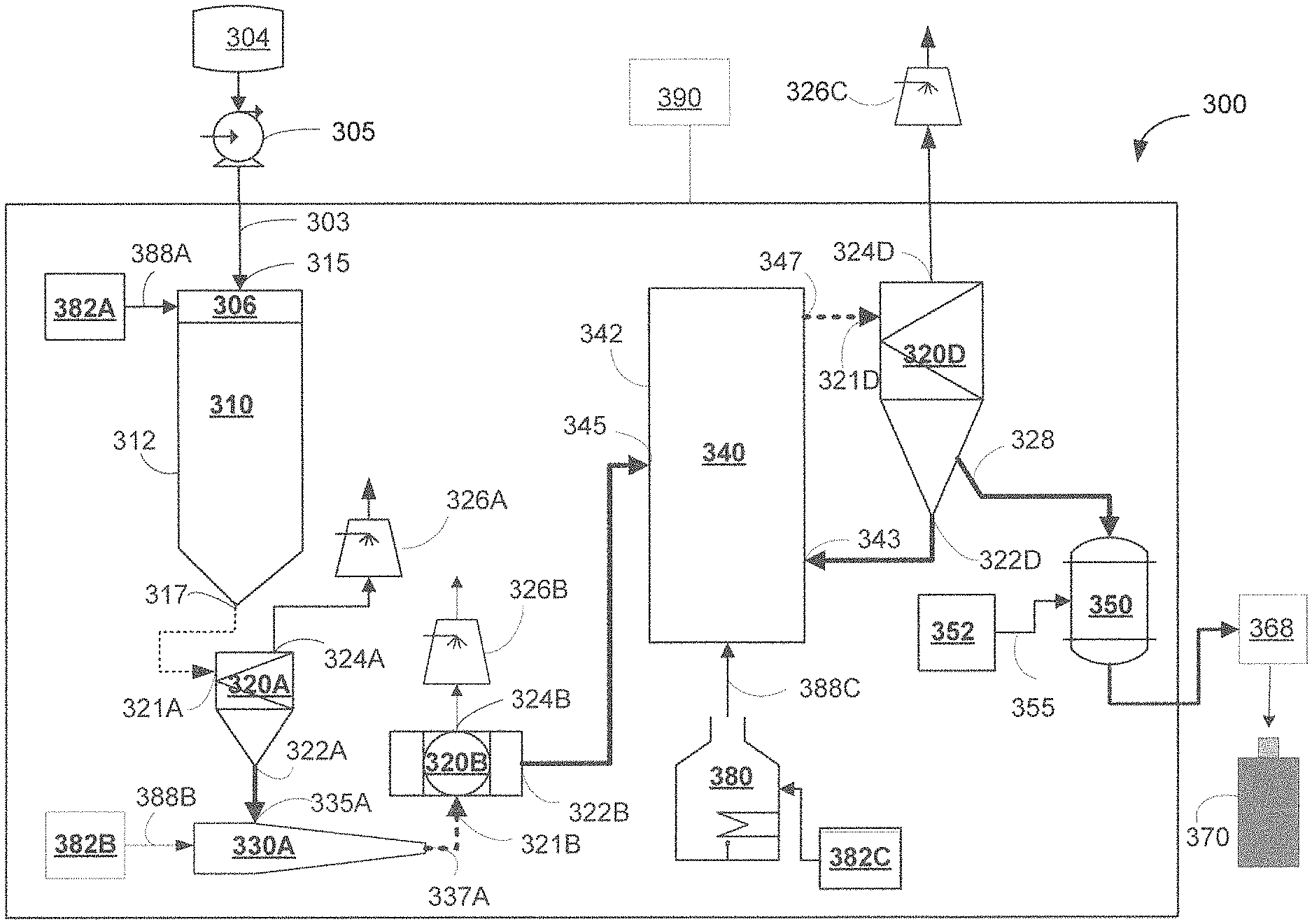Invented by Liang-Yuh Chen, Ejoule International Ltd
Battery cells are the heart of any battery system, and their performance directly impacts the overall efficiency and reliability of the battery. The production of battery cells involves several complex stages, including material preparation, electrode manufacturing, cell assembly, and testing. Each stage requires precise control and optimization to achieve the desired characteristics and performance of the battery cell.
Multi-stage processes offer numerous advantages in the production of battery cell materials. They allow for better control over the composition and structure of the materials, leading to improved performance and durability of the battery cells. These processes also enable the integration of multiple functionalities into the materials, such as enhanced energy density, faster charging capabilities, and increased safety.
One of the key factors driving the market for multi-stage processes is the increasing demand for electric vehicles (EVs). As governments worldwide push for the adoption of clean transportation, the demand for high-performance batteries for EVs has surged. Multi-stage processes enable the production of battery cells with higher energy densities, longer lifespans, and faster charging capabilities, meeting the requirements of the growing EV market.
Moreover, the rising demand for renewable energy storage systems is also contributing to the market growth. As renewable energy sources like solar and wind become more prevalent, the need for efficient energy storage solutions to manage intermittent power generation has become crucial. Multi-stage processes enable the production of battery cells that can store and release energy efficiently, supporting the widespread adoption of renewable energy technologies.
Furthermore, advancements in materials science and manufacturing technologies have also fueled the market growth. Researchers and manufacturers are constantly exploring new materials and processes to enhance the performance of battery cells. Multi-stage processes allow for the integration of advanced materials, such as high-capacity cathodes and solid-state electrolytes, into the battery cell structure, improving its overall performance.
However, the market for multi-stage processes for producing battery cell materials is not without challenges. The high capital investment required for setting up multi-stage production facilities and the complexity of the processes pose significant barriers to entry for new players. Additionally, the stringent safety and environmental regulations associated with battery production also add to the complexity and cost of implementing multi-stage processes.
Despite these challenges, the market for multi-stage processes for producing battery cell materials is expected to witness substantial growth in the coming years. The increasing demand for electric vehicles, renewable energy storage systems, and advancements in materials science will continue to drive the market. Moreover, ongoing research and development efforts aimed at improving the efficiency and sustainability of battery production processes will further propel the market growth.
In conclusion, the market for multi-stage processes for producing a material of a battery cell is experiencing significant growth due to the increasing demand for electric vehicles and renewable energy storage systems. These processes enable the production of high-performance battery cells with improved energy density, longer lifespans, and faster charging capabilities. Despite the challenges associated with capital investment and regulatory compliance, the market is expected to expand further as technological advancements and research efforts continue to enhance the efficiency and sustainability of battery production processes.

The Ejoule International Ltd invention works as follows
A multi-stage process is provided to convert one or more precursor compounds into battery material. The system comprises a mist-generator, a drying room, one of more gas solid separators and one, or more, in-line reactions modules consisting of one, or more, gas-solid feeders and separators and one, or more, reactors. The internal plenums in the drying chamber, gas-solid feeders and reactors form various gas-solid mixtures. The processing system uses heated air or gas as an energy source and as a gas source to form the gas-solid blends. This helps improve the reaction rate and uniformity. The processing system continuously delivers the precursor compounds and processes them in-line, through the internal plenums and reaction modules of the drying chamber.

Background for Multi-stage Process for Producing a Material of a Battery Cell
The development of advanced electrochemical batteries has been made to meet the increasing demand for consumer electronics, electric vehicles, and grid energy storage in terms of high performance, high capacity and long cycle life. They also have low costs and excellent safety. It is important that batteries are compact, lightweight, and rechargeable to conserve space and materials.
In an electrochemically-active battery cell, the cathode is immersed in electrolyte while anode is separated electronically by a separator. The separators are typically made from porous polymer materials so that metal ions released by the electrodes can diffuse and migrate through the pores. The metal ions which are transported between the cathode-anode electrodes of a cell determine its type. Over the years, a variety of rechargeable secondary battery types have been commercially developed, including nickel-metal hydride, lead acid, lithium ion, and lithium ion Polymer batteries. A rechargeable secondary batteries must be high-energy density, high-power density, and safe to be commercially used. There is a tradeoff between power density and energy density.
The lithium ion secondary battery was invented in the early 90s. It has many advantages over other secondary batteries. These include high energy density and long cycle life. There is also no memory effect. The Lithium Ion Battery quickly gained acceptance, and it dominated the secondary battery market. The cost of commercially producing various lithium battery materials are significantly higher than for other secondary batteries.
Cathode materials are the most costly component of a Li-ion battery. They determine, in a large part, the energy density, the cycle life, the manufacturing cost, and the safety of the lithium battery cell. Lithium cobalt oxide material (LiCoO2) was used as a cathode when the lithium battery first became commercialized. It still has a large market share on the cathode-active material market. Cobalt, however, is both toxic and costly. LiMeO2 is another lithium transition metal oxide material, where the metal Me?Ni, Mn, Co, and so on. ; e.g., LiNi0.33Mn0.33Co0.33O2, with their reversible/practical capacity at around 140?150 mAh/g), spinel structured LiMn2O4 (with reversible/practical capacity at around 110?120 mAh/g), and olivine-type lithium metal phosphates (e.g., LiFePO4, with reversible/practical capacity at around 140?150 mAh/g) have recently been developed as active cathode materials. The spinel-structured LiMn2O4 material exhibits poor battery cycle life, while the olivine type LiFePO4 material has a low energy density with poor low temperature performance. LiMeO2 has a better electrochemical performance, but the manufacturing process can produce agglomerates. This means that electrode density is lower for LiMeO2 than LiCoO2. The manufacturing processes used to produce materials for battery applications are expensive, as they require a lot of time and energy.
The conventional material manufacturing processes, such as the solid-state reaction process (e.g. mixing solid precursors, followed by calcination), and the wet-chemistry process (e.g. treating precursors through co-precipitation or sol-gel reactions, followed by mixing and calcination), have significant challenges when it comes to generating nano and micron-structured products. It is hard to produce solid materials with the desired particle size, shape, crystal structure, morphology and stoichiometry. For complete reaction, grain growth, and homogeneity in conventional solid-state reactions, long calcination times (e.g. 4-20 hours) are required. Solid-state reactions, such as those that produce spinel-structured LiMn2O4 or olivine-type LiFePO4 require a long calcination time (e.g. 4-20 hours) and an additional annealing step. Solid-state reactions are hampered by the presence of chemical and temperature gradients (such as oxygen) inside the calcination oven. This limits performance, consistency, and quality.
Wet chemistry processes at low temperatures usually result in faster chemical reactions. However, a separate high-temperature calcination and possibly an additional annealing step is still needed afterward. Chemical additives, gelation and surfactants are required for a wet-chemistry process. These will increase the cost of manufacturing the materials (in purchasing additional chemicals, and adjusting the specific process sequence, temperature, pH and rate) and can also affect the composition of the active materials as produced (requiring additional steps to remove unwanted chemicals or filter products). The primary particle sizes of wet-chemistry powders are small and tend to aggregate into unwanted large-sized secondary particles. This affects the energy packing density. The morphologies are often undesirable, such as amorphous aggregates and porous agglomerates. Also, powder particles produced in this way can exhibit wires, rods or flakes. “Uniform particle sizes and shapes that allow for high packing densities are desired.
Since the water solubility of these Ni(OH)2, Co(OH)2, and Mn(OH)2 precursor compounds are different and they normally precipitate at different concentrations, the pH of a mixed solution of these precursor compounds has to be controlled and ammonia (NH3) or other additives has to be added slowly and in small aliquots to make sure nickel (Ni), manganese (Mn), and cobalt (Co) can co-precipitate together to form micron-sized nickel-manganese-cobalt hydroxide (NMC(OH)2) secondary particles. These co-precipitated NMC (OH)2 secondary particle are usually agglomerates from nanometer-sized particles. The final lithium NMC Transitional Metal Oxide (LiMeO2), which is made from NMC(OH2)2 precursor compounds, are also agglomerates. These agglomerates can break under high-pressure during the electrode calendaring step, and when they are coated onto a collector foil. When these lithium NMC Transitional Metal Oxide materials are used as a cathode-active material, relatively low pressurization pressure is required in the calendaring step. This limits the electrode density.
There is therefore a need for improved processes and systems to produce high-quality, structured active materials in a battery cell.
This invention is a general method of preparing materials used in battery applications. The invention was more specifically a method and system to produce material particles (e.g. active electrode materials etc.). In desirable crystal sizes, shapes and morphologies. In one embodiment, an in-line multi-stage processing system is used to produce a material for a battery. The processing system includes one or several processing modules, which are made up of a mist-generator, a drying room, one or multiple gas-solid separators and one or many in-line reactions modules. The reaction modules can include one or several gas-solid feeders or reactors. Optionally, one or two gas-solid separators are also included. The reaction modules and processing modules are designed for multi-stage conversion of one or several precursor compounds into reaction product particles. Another embodiment provides one or more cooling systems to lower the temperature for final reaction product particle particles.
The internal plenums in the drying chamber, one or more feeders for gas-solids and one or several reactors form various gas-solid mixtures. The heated gas or air is also used as an energy source to speed up and ensure uniformity in the reactions within the drying chamber, gas-solid feeders and/or reactors. The solid precursors are continually delivered to the processing modules and reaction modules of a processing system. They are then processed through the various plenums in the chambers, reactors and/or reactors that make up the processing system into final reaction products.

In one embodiment, the method for producing active materials (e.g. cathode and anode) is described. The method comprises drying a mixture of one or more liquid precursors, a mist and a flow in a chamber at a temperature of a certain amount for a predetermined time. It then separates the mixture into two types of solid particles. The first type of solid particle of one or several precursor compounds is then delivered to one or multiple multi-stage reaction modules in-line for further reaction. In a first module, the first type solid particles are mixed with a flow of second gas heated up to a higher temperature. The second gas-solid mix is then separated into the second type solid particles and the side product. The second type solid particles are then delivered to a second reactor module in order to create a mixture of the second type solid particles with a flow of third gas heated up to a temperature of third. The third gas-solid mix is then reacted inside the reactor for a second time and a reacted mixture of gas-solid is formed. The reacted mixture of gas and solid is cooled in order to obtain the final reacted particles.
In one aspect, the final solid particles of the reaction are suitable for use as active electrode materials to be further processed into electrodes of a cell. In another aspect, a reacted gas/solid mixture is separated to form a third type solid particle and a side product. The third type solid particle is then further processed into battery material. In a further aspect, a flow of cooling fluid may be used to reduce the temperature of either the final solid particles or the third type. In another aspect, a flow is delivered of a cooling liquid to be mixed with final reacted particles to form a gas-solid mixture and cool its temperature. The cooled mixture of gas and solid is separated into final cooled solid particles, and a fourth product.
In another embodiment of the method for producing a material used in a battery electrochemical cells, a mixture is dried at a temperature of a mixture of liquid and first gas for a period of time, inside a chamber for drying, then separated into a mixture of first solid particles and first side products. The first type of solid particle is then delivered to one or more multistage in-line modules of a system of processing for further reaction. “The method also includes the formation of a second mixture of gas and solid in a first module, as well as the formation a third module of gas and solid in a secondary module.
In the first reaction module the second gas-solid mix formed by the first type solid particles in combination with a flow of second gas heated at a higher temperature is reacted over a longer residence time, and then separated into the second type solid particles and the second side product. The second type of solid particle is then continuously delivered into a secondary reaction module. In the second module, a reaction is carried out in a reactor during a third time period. The third gas-solid mix formed by the second type solid particles and the flow of a tertiary gas heated to the third temperature. A portion of the gas-solid mixtures in the reactor are then delivered out and separated into third type solid particles and third side products. The method also includes circulating part of the third-type solid particles into the reactor for them to be reacted during a fourth residence inside the reactor, forming a gas-solid mix and then separating it into final reacted particles and a forth side product. A cooling fluid can be delivered to the final solid particles in order to form a cooled solid gas mixture. The cooled mixture of gas and solid can be separated to form a final reacted particle, a side product and a cooled fluid.
In a third embodiment, the method for producing a material used in a battery electrochemical cells includes drying the first mixture made from a mist formed by a liquid and the flow of first gas at a temperature of one for the first time. Then, the mixture is separated into a solid particle of the first kind and the side product. A second mixture, formed from solid particles of the first kind and the flow of second gas heated to two temperatures inside a gas solid feeder, is then reacted for the second time The second type of solid particle is then delivered to a liquidized bed reactor where it is mixed with a flow a a third heated gas to a 3rd temperature. Fluidized bed reactions can be annular fluidized beds, flash fluidized beds, or circulating fluidized beds. The third mixture is then reacted in the fluidized-bed reactor for a third time, resulting in a reacted mixture of gas and solid. The fluidized bed reactor then delivers the reacted mixture. The reacted mixture of gas and solid can be further processed or cooled to produce final reacted particles. In one aspect, a cooling fluid is mixed with the final solid particles to create a cooled solid-gas mixture and lower the temperature of these final solid particles. The cooled mixture of gas and solids is separated into final reacted particles, a third product and the cooled mixture.
In a further embodiment, it is possible to manufacture a battery cell material using a multi-stage processing system in line. The processing system comprises a drying room connected to a gas line and configured to flow a gas into the chamber. It also includes a gas-solid separation unit connected to the chamber.
The processing system also includes one or two gas-solid feeders and one or two second gas-solid separaters. It may also include one or several reactors. One or more of the gas-solid feeds are connected to a first gas solid separator and a second or additional gas line. The gas solid feeders receive granules of the first solid type from the separator. They then mix the second gas with this first solid type and create one or several gas-solid mixtures. One or more second separators connected to one or multiple gas-solid feeders separate one or several gas-solid mixtures in one or two types of solid particles, and possibly one or many side products. The one- or two-reactors are connected to one or both of the second gas solid separators, and a gas third line that flows through the third gas.
In one aspect, a mist-generator may be connected to the drying room and configured to produce a mist using a liquid mixture containing one or more precursors. The processing system can also use heated gas that has been pre-heated and is flowing from one or several gas lines to the processing system to provide energy to react different gas-solid mixtures to final reaction products.
Click here to view the patent on Google Patents.

Leave a Reply